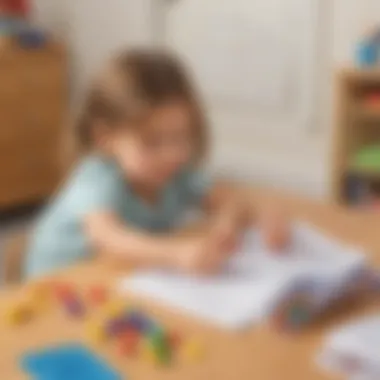Unlocking Math Word Problems for Kindergarten Minds: A Complete Guide to Success


Fun Quizzes
Make learning math word problems enjoyable and effective by incorporating fun quizzes that engage kindergarten students and reinforce their knowledge in a playful manner. These quizzes cover various topics and question types designed to stimulate critical thinking and problem-solving skills in young learners, providing a holistic approach to numeracy development.
Quiz Topics:
Quizzes on elementary math word problems can range from basic addition and subtraction to more complex concepts like patterns and sequences. By introducing a variety of quiz topics, children are exposed to different mathematical scenarios, promoting a comprehensive understanding of fundamental math principles.
Question Types:
Diversifying question types in quizzes is crucial to keeping children interested and challenged. Utilize multiple-choice questions, fill-in-the-blank exercises, and visual representations to cater to different learning styles and enhance problem-solving abilities. By presenting questions in various formats, quizzes become interactive learning tools that spark curiosity and creativity.
Knowledge Reinforcement:
Quizzes play a vital role in reinforcing and solidifying mathematical knowledge gained through regular practice and application. By regularly engaging in quizzes, kindergarten students can consolidate their understanding of math word problems and build confidence in tackling different scenarios. The gamified nature of quizzes also makes learning enjoyable and motivating, leading to enhanced retention of mathematical concepts.
Introduction
Math word problems for kindergarten students hold significant importance in early education. In this article, we will delve into the realm of mathematical challenges tailored for young learners aged 5-6, providing a detailed overview of how to introduce and practice these concepts effectively. By exploring basic mathematical operations and cultivating problem-solving skills, this guide aims to enhance numeracy abilities in an interactive and engaging manner.
Importance of Early Math Learning
Building Foundation for Future Math Skills
The foundation laid during early math learning plays a pivotal role in shaping a child's future mathematical capabilities. By establishing core mathematical concepts at a tender age, such as addition, subtraction, multiplication, and division, students develop a solid groundwork for advanced math skills later on. This focus on foundational principles not only nurtures a deep understanding of core mathematical operations but also cultivates logical reasoning and analytical thinking essential for higher-level problem-solving. The meticulous attention to detail in honing these fundamental skills is a strategic approach in ensuring comprehensive mathematical proficiency for kindergarteners.
Enhancing Critical Thinking and Problem-Solving Abilities
Enhancing critical thinking and problem-solving abilities at an early stage equips students with invaluable skills that transcend the realm of mathematics. By engaging young minds in deciphering math word problems, students are encouraged to think critically, analyze information, and devise innovative solutions. This process fosters a mindset of curiosity and exploration, promoting resilience in tackling challenges across various academic and real-world scenarios. Through the cultivation of these skills, children develop a robust problem-solving toolkit that not only enhances their mathematical aptitude but also fosters adaptability and perseverance crucial for holistic growth.
Benefits of Introducing Word Problems
Real-World Relevance
The integration of real-world relevance in math word problems bridges the gap between theoretical concepts and practical applications. By contextualizing mathematical challenges within familiar everyday scenarios, students can grasp the tangible value and application of math in their daily lives. This approach not only instills a sense of purpose and relevance in mathematical learning but also nurtures problem-solving skills that can be directly applied to real-world situations. The incorporation of real-life contexts in word problems serves as a powerful motivator for young learners, inspiring a genuine interest in mathematical exploration.
Integration of Language and Math Skills
The integration of language and math skills in word problems promotes a harmonious blend of two distinct yet interconnected domains of learning. By encouraging students to articulate and interpret mathematical concepts through language, educators foster a multifaceted understanding of numeric relationships and problem-solving strategies. This interdisciplinary approach not only enhances communication skills but also strengthens conceptual clarity and analytical abilities. Through the seamless integration of language and math, students develop a holistic appreciation for the interconnectedness of various academic disciplines, paving the way for a comprehensive educational journey.
Target Audience
Kindergarten Students (Ages 5-6)
Kindergarten students aged 5-6 represent a unique audience with specific learning needs and cognitive capabilities. Tailoring math word problems to this age group is paramount in laying a robust educational foundation and nurturing a love for learning. By engaging kindergarteners in age-appropriate mathematical challenges, educators can effectively stimulate curiosity, encourage exploration, and instill a passion for problem-solving. This early exposure to mathematical concepts not only fuels intellectual curiosity but also sets the stage for continuous growth and development in numeracy skills. Embracing the distinctive characteristics and potentials of kindergarten students fosters a supportive learning environment conducive to meaningful educational experiences.


Understanding Math Word Problems
Understanding math word problems is a crucial aspect of early math education for kindergarten students. In this comprehensive guide focused on exploring math word problems, it is essential to grasp the fundamental concepts that form the basis of numerical reasoning. By delving into addition, subtraction, simple multiplication, and division, young learners begin to develop foundational skills that are integral to problem-solving and critical thinking abilities. The significance of mastering these basic operations lies in their application to real-life scenarios, enhancing students' logical reasoning and analytical skills.
Basic Concepts
Addition and Subtraction
In the realm of math word problems, addition and subtraction play a pivotal role in building young learners' numerical fluency. Addition, the process of combining groups of objects, fosters an understanding of quantitative relationships and introduces the concept of 'adding to.' Subtraction, on the other hand, involves taking away or finding the difference between quantities, cultivating the ability to 'take away from' or 'compare.' These fundamental operations not only strengthen students' arithmetic skills but also lay the foundation for more complex mathematical concepts.
Simple Multiplication and Division
Introducing kindergarten students to simple multiplication and division expands their mathematical repertoire by introducing the concepts of equal groups and sharing equally. Multiplication entails the repeated addition of the same number, emphasizing the concept of 'groups of,' while division focuses on partitioning and distributing a quantity into equal parts. These operations provide young learners with versatile strategies for solving word problems and offer an introductory glimpse into the world of multiplication tables and division facts.
Problem-Solving Strategies
Identifying Key Information
An essential aspect of solving math word problems involves identifying key information to extract relevant data and variables. By pinpointing essential details such as numbers, quantities, and relationships presented in a word problem, students can dissect the problem effectively and devise a strategic plan for finding a solution. This strategy enhances critical thinking and analytical skills, promoting a systematic approach to problem-solving that is essential for mathematical proficiency.
Drawing Visual Representations
Visual representations serve as powerful tools for elucidating complex word problems and aiding in the visualization of mathematical concepts. By employing diagrams, pictures, or models to illustrate problem scenarios, students can enhance their understanding of abstract mathematical concepts and streamline the problem-solving process. Visual aids not only facilitate clearer comprehension but also promote spatial reasoning skills and foster a visual-spatial learning style.
Common Keywords in Word Problems
More Than, Less Than, Equal To
Keywords such as 'more than,' 'less than,' and 'equal to' are integral components of word problems that indicate comparative relationships between quantities. These keywords signal disparity, equivalence, or relative magnitude, prompting students to discern and compare numerical values within a problem context. Understanding these relational cues sharpens students' relational thinking and encourages them to interpret numerical data based on specific conditions outlined in the problem statement.
GroupsTotal, Difference
The presence of keywords like 'groupstotal' and 'difference' in word problems prompts students to engage with concepts related to grouping, combination, total quantities, and discrepancies between values. By identifying these keywords, students navigate through problem scenarios involving partitioning, aggregating, or finding variations across specific quantities. Leveraging these keywords equips students with the proficiency to decipher problem structures and derive meaningful solutions through logical reasoning and quantitative analysis.
Practical Tips for Teaching Math Word Problems
In this section of the comprehensive guide on Exploring Math Word Problems for Kindergarten Students, focusing solely on Practical Tips for Teaching Math Word Problems holds immense relevance. By delving into the nuances of teaching math word problems effectively, educators can enhance students' understanding of foundational math concepts and foster critical thinking skills from an early age. The specific elements to consider in this section encompass strategies for engaging young learners, tailoring instruction to diverse learning styles, and incorporating real-life scenarios to make learning more relatable and impactful.
Creating Engaging Story Contexts
Incorporating Daily Life Scenarios:
When discussing the pivotal aspect of Incorporating Daily Life Scenarios in teaching math word problems, the primary goal is to make abstract mathematical concepts tangible and relevant for young learners. By relating math problems to everyday situations like sharing toys or counting fruits, children can grasp the practical significance of numerical operations in their lives. The key characteristic of this approach lies in its ability to bridge the gap between theoretical math concepts and real-world applications, allowing students to see mathematics as a tool for problem-solving in their daily routines.
Utilizing Visual Aids:
Turning the spotlight onto Utilizing Visual Aids in teaching math word problems amplifies the learning experience by providing visual reinforcement to abstract ideas. Visual aids such as diagrams, pictures, or manipulatives help to illustrate mathematical concepts clearly, aiding in comprehension and retention. The significant advantage of incorporating visual elements is that it caters to different learning styles, making the learning process more inclusive and engaging for all students. However, it's essential to balance visual aids with verbal explanations to ensure a comprehensive understanding of the mathematical concepts being taught.


Encouraging Critical Thinking
Prompting Students to Explain Their Reasoning:
The cornerstone of Encouraging Critical Thinking in math education involves prompting students to articulate their reasoning behind problem-solving strategies. By encouraging students to verbalize their thought processes, educators can assess comprehension levels and guide students towards deeper conceptual understanding. This approach fosters analytical thinking, enhances communication skills, and nurtures self-expression, essential for developing strong mathematical reasoning abilities.
Encouraging Multiple Solution Approaches:
By advocating for Multiple Solution Approaches in solving math word problems, educators empower students to think flexibly and creatively. Encouraging diverse solution methods not only promotes problem-solving versatility but also cultivates resilience and adaptability in the face of complex mathematical challenges. Students can explore various pathways to reach a solution, honing their analytical skills, and broadening their problem-solving repertoire, preparing them for tackling diverse mathematical scenarios with confidence.
Gradual Progression in Complexity
Start with Simple Problems and Increase Difficulty:
Initiating learning with Simple Problems and gradually ramping up complexity contributes significantly to student mastery of mathematical concepts. By starting with accessible problems that build confidence and understanding, educators lay a solid foundation for students to tackle more intricate challenges with ease. This progression allows for scaffolding of knowledge, ensuring that students grasp fundamental concepts before moving on to advanced topics, promoting a structured and comprehensive learning journey.
Scaffold Learning for Mastery:
Scaffolding Learning for Mastery reinforces the idea of providing adequate support and guidance to students as they navigate through increasingly intricate math word problems. This approach involves breaking down complex problems into manageable steps, offering targeted assistance, and gradually releasing responsibility to students as they gain proficiency. Scaffolding ensures that students build upon prior knowledge, filling gaps in understanding, and consolidating learning for sustained mastery and application in varied mathematical contexts.
Interactive Math Activities and Resources
In the realm of early math education, the incorporation of interactive math activities and resources stands as a cornerstone in cultivating a deep understanding of mathematical concepts among kindergarten students. These activities serve as dynamic tools that not only engage young learners but also promote active participation and hands-on practice, essential for solidifying comprehension. By immersing children in interactive math experiences, educators can create a stimulating learning environment that encourages exploration and discovery, setting the stage for nurturing a strong foundation in numeracy skills.
Online Tools and Apps
Interactive Games for Word Problem Practice
Interactive Games for Word Problem Practice play a crucial role in reinforcing the application of mathematical principles within real-world scenarios. These games offer a platform where students can interact with math concepts in a fun and captivating manner, enhancing their problem-solving abilities while making learning enjoyable. The key characteristic of these interactive games lies in their ability to present complex mathematical problems in a simplified and interactive format, allowing young learners to grasp challenging concepts with ease. Their user-friendly interfaces and gamified elements make them a popular choice for educators seeking to engage students in meaningful math practice, bridging the gap between theoretical knowledge and practical application.
Digital Worksheets for Hands-On Learning
Digital Worksheets for Hands-On Learning provide a versatile and accessible means of reinforcing math skills through practical exercises and activities. These worksheets offer a tailored approach to addressing individual learning needs, allowing students to engage with math problems at their own pace and level of understanding. The key characteristic of digital worksheets lies in their adaptability and interactive nature, offering immediate feedback and guidance to learners as they navigate through various math challenges. While digital worksheets present clear advantages in terms of convenience and customization, their reliance on electronic devices may pose challenges in terms of screen time management and digital access for all students.
Printable Math Problem Worksheets
Customizable Templates for Varied Skill Levels
Customizable Templates for Varied Skill Levels play a crucial role in providing differentiated instruction that meets the diverse learning needs of kindergarten students. These templates offer educators the flexibility to tailor math problem worksheets according to students' skill levels, ensuring that each child receives personalized content that aligns with their academic capabilities. The key characteristic of customizable templates lies in their adaptability and versatility, allowing teachers to scaffold learning by gradually increasing the complexity of problems as students progress. While customizable templates offer a targeted approach to skill development, their effectiveness hinges on educators' ability to accurately assess students' abilities and provide appropriate challenges.
Math Workbooks and Workshops
Guided Activities to Reinforce Learning
Guided Activities to Reinforce Learning serve as structured exercises that aid in consolidating math concepts explored in the classroom. These activities provide a systematic approach to practicing math skills, offering students step-by-step guidance to reinforce their understanding of key concepts. The key characteristic of guided activities lies in their ability to break down complex problems into manageable steps, promoting a methodical approach to problem-solving that enhances students' confidence and competence. While guided activities offer clear benefits in terms of skill reinforcement, their reliance on teacher guidance and support may require additional classroom resources and time allocation.


Collaborative Problem-Solving Sessions
Collaborative Problem-Solving Sessions foster a collaborative learning environment where students work together to solve math problems as a team. These sessions encourage peer interaction and communication, promoting the exchange of ideas and strategies among students. The key characteristic of collaborative problem-solving lies in its ability to develop students' social and cognitive skills, helping them view problem-solving through different perspectives and approaches. While collaborative sessions offer a platform for cooperative learning, their success depends on effective group dynamics and teacher facilitation to ensure that all students actively participate and contribute to the problem-solving process.
Assessment and Monitoring Progress
Assessment and monitoring progress play a crucial role in this comprehensive guide on exploring math word problems for kindergarten students. Tracking the development of young learners is essential to gauge their understanding and skill acquisition accurately. By assessing their progress, educators can tailor teaching strategies to meet individual needs effectively. Monitoring progress allows for the identification of areas needing improvement and supports the enhancement of overall mathematical proficiency.
Formative Assessment Techniques
Formative assessment techniques within the context of teaching math word problems to kindergarten students are vital for meaningful learning outcomes. By employing observational checklists, teachers can systematically observe students' problem-solving processes and identify their strengths and weaknesses. This method offers valuable insights into individual student progress and aids in shaping instructional interventions. Additionally, verbal questioning serves as a powerful tool to assess students' comprehension of mathematical concepts and their ability to articulate problem-solving strategies effectively.
Observational Checklists
Observational checklists serve as structured tools for teachers to document and analyze student performance during math problem-solving activities. They focus on key skills and behaviors that indicate mathematical understanding, enabling educators to tailor instruction according to identified needs. Through observational checklists, teachers can track students' problem-solving approaches, observe their critical thinking skills in action, and provide targeted support where necessary.
Verbal Questioning
Verbal questioning is a dynamic formative assessment technique that encourages students to articulate their reasoning and thought processes aloud. By posing targeted questions related to math word problems, educators can assess students' problem-solving strategies, logical reasoning abilities, and comprehension of mathematical concepts. Verbal questioning promotes cognitive engagement, enhances communication skills, and allows teachers to gauge individual student understanding through direct interaction.
Tracking Student Development
The systematic tracking of student development in problem-solving skills is paramount in ensuring educational progress and intervention efficacy. By recording growth in problem-solving skills, educators can pinpoint individual learning trajectories, celebrate achievements, and intervene promptly when challenges arise. Adapting teaching strategies based on students' progress facilitates personalized learning experiences and optimizes instructional outcomes for kindergarten learners.
Recording Growth in Problem-Solving Skills
Recording growth in problem-solving skills involves gathering data on students' problem-solving performances over time. This data-driven approach enables educators to identify patterns, assess skill development, and make informed instructional decisions. By tracking progress in problem-solving skills, teachers can create targeted learning experiences, offer timely support, and foster a growth mindset among young learners.
Adapting Teaching Strategies Based on Progress
Adapting teaching strategies based on student progress empowers educators to scaffold instruction effectively and address the evolving needs of kindergarten students. By analyzing data on student performance, teachers can modify instructional approaches, provide differentiated support, and ensure that all learners are appropriately challenged. This adaptive teaching model promotes continuous improvement, fosters a supportive learning environment, and maximizes students' potential for mathematical growth.
Parental Involvement and Support
Parental involvement and support play a pivotal role in the academic success of kindergarten students as they embark on their mathematical journey. Collaboration between educators and parents enhances learning opportunities, reinforces mathematical concepts outside the classroom, and nurtures a cohesive educational experience for young learners.
Home Practice Guidance
Home practice guidance provides parents with strategies and resources to reinforce math learning at home effectively. By offering suggestions for incorporating math word problems into daily routines and activities, educators can promote ongoing skill development and engage parents as partners in their child's mathematical growth. Home practice guidance fosters a collaborative approach to learning, strengthens the home-school connection, and empowers parents to support their child's mathematical journey.
Communication Channels for Feedback
Communication channels for feedback serve as conduits for meaningful dialogue between educators, parents, and students regarding academic progress and challenges. By establishing clear communication channels, such as newsletters, parent-teacher conferences, and digital platforms, schools can promote transparency, share insights on student performance, and solicit feedback for continuous improvement. Effective communication fosters a supportive learning environment, encourages parental involvement, and strengthens the educational partnership between home and school.
Conclusion
In the culminating section of this comprehensive guide on Exploring Math Word Problems for Kindergarten Students, we underscore the vital role of concluding insights. The significance of encapsulating the key discussions and learnings from the preceding sections cannot be overstated. By distilling the essence of early math learning through word problems, educators and parents can gain a holistic view of how these foundational concepts lay the groundwork for future mathematical proficiency. Additionally, emphasizing the benefits of fostering critical thinking and problem-solving skills in young learners is paramount. By providing a dedicated section for conclusion, this article not only summarizes but also reinforces the principles and strategies delineated throughout, offering a cohesive narrative that resonates with both children and adults alike.
Empowering Kindergarten Learners
Nurturing a Love for Math Through Word Problem Exploration
Delving into the realm of nurturing a love for math through word problem exploration unveils a pivotal element in the educational journey of kindergarten students. The essence of instilling ardor for mathematics at an early age cannot be overstated. By integrating math concepts within the context of real-world problem-solving scenarios, educators sow the seeds for a lifelong affinity towards numbers and logic. The key characteristic of this approach lies in its ability to bridge the gap between theoretical arithmetic and practical application, nurturing a deep-rooted appreciation for the subject. By immersing children in interactive and engaging math activities that promote critical thinking and analytical skills, the path towards mathematical fluency is illuminated. This methodological choice is not only beneficial but also essential in cultivating a positive attitude towards math among young learners, setting the stage for a robust mathematical foundation. The unique feature of nurturing a love for math through word problem exploration lies in its adaptability to varied learning styles and paces, catering to the diverse needs of students in a dynamic and inclusive manner. This approach not only enhances numeracy skills but also cultivates a growth mindset, instilling confidence and resilience in tackling mathematical challenges. Overall, nurturing a love for math through word problem exploration emerges as a potent strategy in fostering a generation of young mathematicians equipped with the curiosity and enthusiasm to navigate the complexities of numbers and logic.







